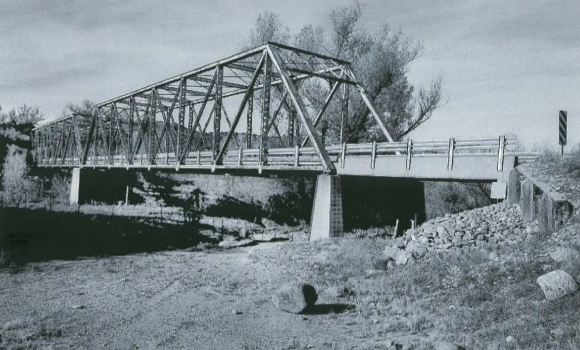Art of Transportation: Here and there
Art of Transportation: Here and there

Given that the majority of us are transportation geeks, it's no wonder that we are a little mesmorized by this photo, showing the back-and-forth riveting and lacing along one of the beams of the bridge that straddles the Verde River at Perkinsville. It's a perfect example of how even the most utilitarian engineering details can have a beauty all of their own.
Now Perkinsville is a weird place for us to be spotlighting, as the ghost town sits in the heart of Yavapai County, northwest of Jerome, far from any state highways. The town sprang into existence as a railway depot for a shortine in 1912. A nearby limestone quarry and kiln helped it produce lime for a smelter at Clarksdale and a copper mine in Jerome. This bridge went up across the river in 1936. However, the closure of the smelter a few decades later led to its rapid decline. Though today it does now serve as a turn-around point for the scenic Verde Canyon Railroad.
That's all well and good, but where does ADOT come in? Well, we did some digging into the bridge's history and found that Perkinsville was not it's first home. For that we have to jump more than 20 years further into the past and some 160 miles to the southeast. According to a historic bridge inventory, Arizona congressman Carl Hayden was able to pass legislation in 1912 for a multi-span steel-and-concrete wagon bridge to be built across the Gila River near Calva on the San Carlos Reservation. The seven-span, nearly 1,000-foot-long bridge was built by Midland Bridge Company out of Kansas City, under the supervision of the Office of Indian Affairs in Washington, D.C. This became an important regional river crossing and was the first of the increasingly common riveted Pratt through truss bridges in the state.
The bridge's abutements would be damaged by flooding and four of the seven spans would be replaced in 1921. Finally, in 1936, it was decided to replace the bridge completely.
And that's where we get invovled. Well, not us exactly, but our predecessor, the Arizona Highway Department. During the Great Depression, the state and the U.S. Forest Service entered into an agreement to find labor projects for unemployed transients living in camps across Arizona. So, with the bridge over the Gila set to be replaced, Arizona Highways Department Bridge Engineer Ralph Hoffman had the idea to use this labor force to dismantle three of its spans and then erect them in the Prescott National Forest. Two of the spans became the Perkinsville Bridge, while the remaining span became a nearby bridge over Walnut Creek. Though other public works were completed under this partnership, the crossings at Perkinsville and Walnut Creek are the only know bridges to have been erected by this program.
The two bridges have remained unaltered to this day at their relatively remote crossings. You can see a full photo of the Perkinsville bridge from 2002 below.


